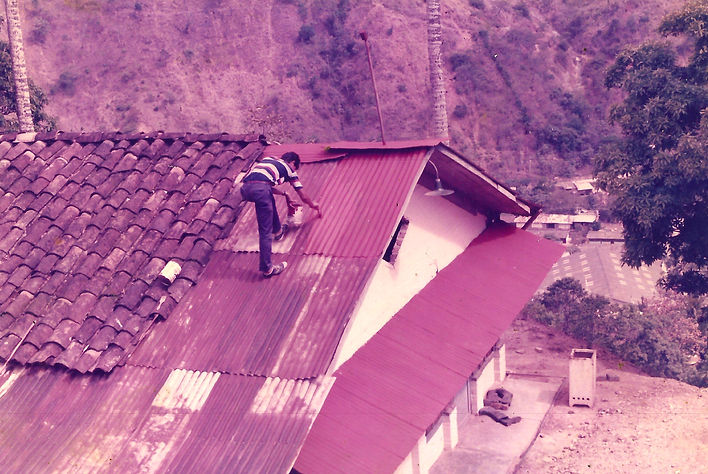

hist

ORIA

Magner Turner, regente del museo empieza una colección en la provincia de Zamora Chinchipe, Oriente Ecuatoriano, esta Provincia por historia metalogenica ofrecía el espacio perfecto para que la creciente colección se asentara. El Barrio Yaguarzongo de la ciudad capital albergo a la pequeña colección desde el año 86 donde el total de piezas no excedía las 1000 contando sobre todo rocas y minerales del Ecuador. Desde el año 87 Magner emprende la durísima tarea de no solo coleccionar sino que catalogar de forma pormenorizada cada una de las piezas, lo que lo llevo a varios viajes dentro y fuera del país. Es así que recorrió Europa, África, Oriente Medio y por supuesto América, en estos múltiples viajes animados por el ávido deseo de coleccionar Magner consiguió recolectar un número importante de rocas mayor a los 3000 piezas y extendió su colección teniendo ya la presencia de ciencias como la cristalografía, paleontología, sedimentología, espeleología, mapas, monedas y estampillas fortaleciendo así la colección hasta ese entonces de carácter netamente privada.
Magner y su familia se asientan en Portovelo, provincia de El Oro en el Año 1993, con una colección en aquella época que sobrepasaba 3000 mil muestras, el lugar elegido para tener amplitud y extender la colección fue el antiguo campamento americano en su zona norte, hoy llamado barrio número uno, en una casa de los 1900 aproximadamente, la edificación construida tanto tiempo atrás se encontraba en escaso estado de conservación por lo que parte de ella debió ser demolida.
Desde su apertura al público en el año 1995 el museo ha recibido hasta el año 2017 un total aproximado de 30,000 turistas motivados de forma específica por el turismo y un total de más de 5,000 visitantes motivados por asuntos de carácter escolar, universitario y científico.
Uno de los atractivos principales fue desarrollado paso a paso y está bajo tierra, el recorrido subterráneo le da al turista la posibilidad de dar un paseo y vivir más de cerca el día a día del minero y conocer los materiales de mina màs de cerca.
El museo poco a poco se convirtió en el valor turístico de mayor visitación en Portovelo y eso le dio la posibilidad de participar en varias ferias a nivel nacional e internacional entre las cuales se cuentan las importantes como, Feria Mundial del Banano, Feria Nacional de la Minería, Feria Nacional del Café, Bienal de Austria, Exposiciones en Chicago, New York, Miami, Las, Vegas, esto le ha valido al museo para ser visitado por personas ilustres de Universidades de diferentes partes del mundo, embajadores, presidente y ex presidentes de la república del Ecuador, Ministros, alcaldes de ciudades principales del Ecuador, Reinas de Belleza, entre otras personas con altas distinciones, hoy en día como parte de la Red Nacional de Museos del Ministerio de Cultura y Patrimonio el museo se asienta con fuerza en el imaginativo común de Portovelo, El oro y El país.
History
Magner Turner, regent of the museum begins a collection in the province of Zamora Chinchipe located in the south Amazon region, a well known metallogenic area thru the history. That was the perfect space for the growing collection to settle. The Yaguarzongo neighborhood of the capital city was the place where the small collection started since the year of 1986, back then the number of pieces did not exceed 1000, especially counting rocks and minerals from Ecuador.
From the year 87 Magner undertakes the hard task of not only collecting but cataloging in detail each of the samples of the collection, which led him to several trips inside and outside the country. This is how he got to travel to: Europe, Africa, the Middle East and of course America (South and North), in these multiple trips animated by the avid desire to collect Magner was able to collect a significant number of rocks, more than 3000 pieces and extend his collection, increasing it to have other sciences such as Crystallography, paleontology, sedimentology, speleology, maps, coins and stamps thus strengthening the collection, until that moment of a purely private nature.
Magner and his family moved to Portovelo, province of El Oro in 1993, with a collection at that time that exceeded 3,000 thousand samples. The place chosen to have amplitude and extend the collection was the former American camp in its northern area, today called "Barrio Numero Uno", in a house approximately from 1900, the house built so long ago had a poor state of conservation so a part of it must have been demolished in orther to have spaces according the need for the collection.
Since its opening to the public in 1995, the museum has received until 2017, a total of 30,000 tourists specifically motivated by tourism and a total of more than 5,000 visitors motivated by matters of a school, university and scientific nature.
The museum as collection has participated in several fairs all over the country, winning at least 30 prizes of many different nature as well as Feria Nacional de la Mineria, Feria Nacional del Café, Feria Mundial del Banano, Feria Binacional de Huaquillas, Expo ESPOL, Expo Palacio de Cristal in the City of Guayaquil for the independence celebrations, it was also de host of the first Bienal of el Oro Province, has also been exposed in Austria, USA, and other countries.
The Museum has turned into the most important touristic value of Portovelo, receiving the visit of Universities from all over the world, beauty queens, Presidents of the Republic, Ministries, Ambassadors, scientific community and other important personalities from Ecuador and the world. Today the museum is part of the National Museums Network of the Ministry of Culture which gives stability and good hopes for the future.

